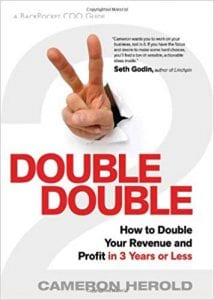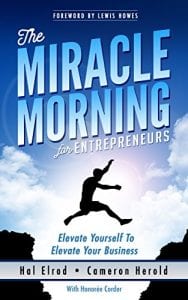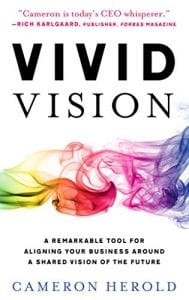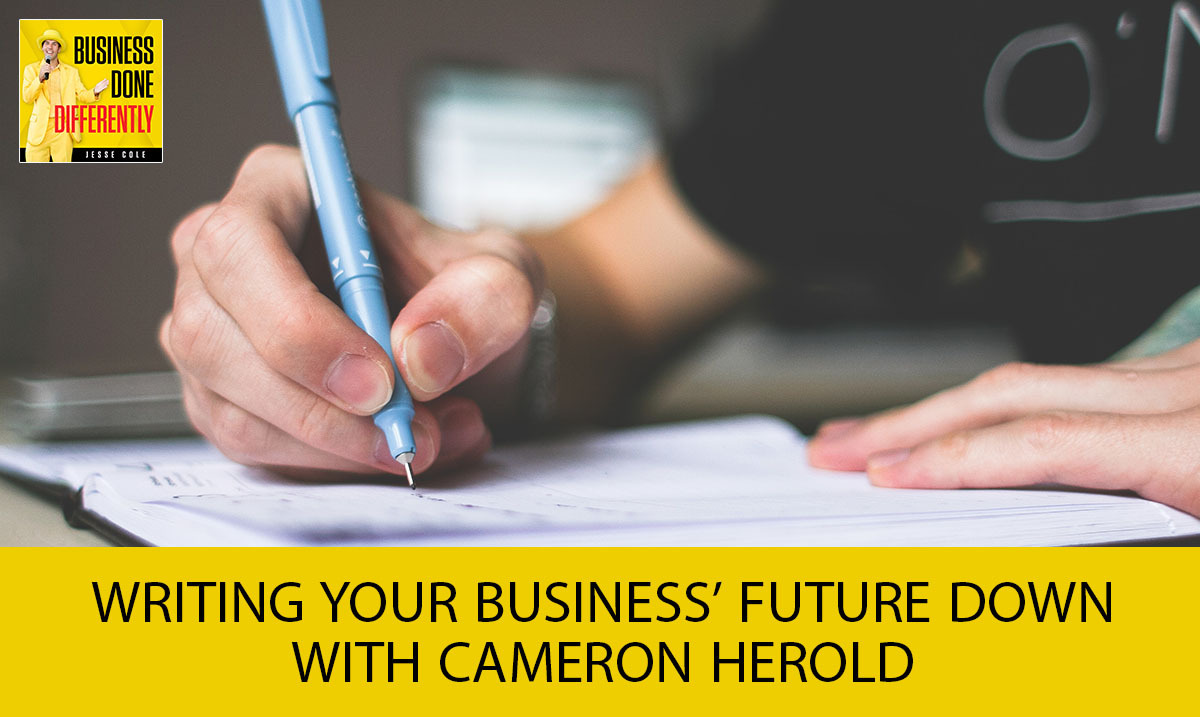Writing Your Business’ Future Down with Cameron Herold | Ep. 155
Part of business is looking out into the future, that is why we have all of these vision statements around. However, what most entrepreneurs miss is the aspect of actually laying down into details what that future is. As a result, no one in the company knows exactly what they are working towards in each step. Known around the world as the CEO Whisperer and marketing and PR expert, Cameron Herold talks about leaning out into the future and getting the employees to own the outcome and the result. Cameron puts forward the need to make your people feel that they are part of something, placing right in front of them the scheme of things in the company and having them take ownership of their roles within that. Tapping into his PR expertise, Cameron offers some great tips for those who are trying to generate some free PR, giving pointers on who to call and how to do it.
—
Listen to the podcast here:
[smart_track_player url=”https://businessdonedifferently.podbean.com/mf/play/qwapkp/BDD_155_Cameron_Herold.mp3″ title=”Writing Your Business’ Future Down with Cameron Herold | Ep. 155″ artist=”Jesse Cole” image=”https://findyouryellowtux.com/wp-content/uploads/2018/12/jesse_cole.jpg” ]Writing Your Business’ Future Down with Cameron Herold

Our guest is the man, the myth, the legend and the one that is known around the world as the CEO Whisperer, Cameron Herold. Cameron helped build two $100 million companies including driving 1-800-GOT-JUNK?’s spectacular growth from $2 million to $106 million in a few years. He’s a marketing and PR expert and he’s helped his companies land over 5,200 media placements, including coverage on Oprah and on thousands of Starbucks cups. His books, Vivid Vision, The Miracle Morning for Entrepreneurs, Meetings Suck and Double Double have all become bestsellers around the world. Cameron’s purpose is simple. To help you exceed your vision. We’re going to do just that. Cameron, welcome to the show.
Thanks for having me. You dug up the old Starbucks quote story. That was a long time ago. We ended up on about seven million Starbucks cups in North America wide for free.
We both believe that attention beats marketing and when you can create attention, a lot of amazing things can happen. For me, I know you started the Vivid Vision in Double Double and you mentioned it in The Miracle Morning For Entrepreneurs, but then came out with a book. For all the audience, that hit me right between the eyes. I spent a few weeks during the summer crafting out this vision, riding on the beach every morning and now I’m working with a group to publish it. Can you share with the audience how this happened? I know 1-800-GOT-JUNK? and how you were able to implement it.
We covered it in Double Double, the Miracle Morning for Entrepreneurs and then my third book was called Vivid Vision. The whole idea is that most entrepreneurs have an idea in their mind what their company looks like in the future but at best, they give their employees a one-sentence mission statement. The employees have no idea what they’re supposed to be building. The idea is to lean out into the future and describe everything you see around your company a few years from now. You describe the meeting rhythms, the employees and the culture. You describe what the media is writing about you, what your customers are saying about you. It’s almost as if you’re standing in the middle of your company a few years from now and you describe what you see. You end up with a four or five-page written document describing your company in its future state. Not talking about how you made it happen but describing it in its finished state.
It was one of the most inspirational exercises anybody can ever do. We’re in the infancy that we’ve written it. How did you get everyone on board? How did you implement this? You started 1-800-GOT-JUNK? and scaled the company to unbelievable lengths. How did you get everyone on board?
Once you have your rough draft as the entrepreneur, you get your four-page Word document version of it. You pass it off to a good copywriter. I’ve got a couple that I refer people to all the time. The basic idea is that you want a professional copywriter to make it pop off the page then you add some of your design elements to it so it feels like your brand. You start giving it to everyone. You give a copy of it to every employee. You give a copy of it to every potential employee. You give a copy of it to every customer. In your case, you’d be giving copies of it to your fans. You give a copy of it to your lawyer, your banker, your accountant, all of your suppliers. Everyone gets a copy of what your future looks like and you ask them to read it every three months. In that way, everyone’s thinking about the future but they’re acting on it today.
When you started sending to everyone, what happened?
They started coming up with ideas. They start coming up with some of their own ideas of what the future could look like. They also start seeing some real value in their work. They start understanding why they’re working on specific projects or why certain initiatives are important. They start seeing a lot more value in their day-to-day work because they see what part of the future Vivid Vision is making come true.
[bctt tweet=”Getting your employees to dream is a very special thing.” via=”no”]For all the audience, I first shared the idea of the Vivid Vision with our group during a staff chat morning meeting and you could see the excitement. Us, as entrepreneurs and you as well Cameron, we think big. We had these dreams of where we want to be and where we want to take it, but we can’t articulate it that well. Once we shared it and they started seeing, I saw this unbelievable energy from the staff. It’s like, “Now this all makes sense.” Is that what happened when you’ve worked with these companies?
Yes and they are also a lot more excited to build something in the future than they are to look at the company as it exists now. Now isn’t inspiring. It’s great, but it’s just now. We all want to work towards something whether we’re building a jigsaw puzzle, whether we’re building a home, whether we’re building a better life, whether we’re building a better family. We always are striving to build something. It gives us some focus and some excitement and energy in our day.
It gives us purpose. If you think about it, if everyone thinks they’re going through their 9 to 5 and I talk about this in my book, Find Your Yellow Tux. You’re putting out fires and you’re going through busy work. I’m sure even if it’s not the most profound purpose in the world, it’s still a purpose for the employees.
It’s like the story of those three bricklayers that are making bricks. They asked the one guy, “What are you doing?” He says, “I make bricks.” The second guy, “What are you doing?” “I’m making a wall and I’m making the bricks to build the wall.” The third guy, “What are you doing?” He said, “I’m building a cathedral to worship God and I’m building the left wall of the cathedral. I get to make the bricks to build that wall.” They’re all making bricks but one guy sees the bigger picture. That’s part of it. The other thing that happens is people start conspiring to help make it come true. They start seeing little things. They’ll be like, “I know the guy that can make this happen. I know the girl that can introduce us to make this part come true. Can I work together with these three people to make this sentence complete?” They started seeing one sentence at a time. The whole Vivid Vision starts to unfold.
The fascinating thing you talk about too, which I don’t think enough companies discussed. It’s about creating entrepreneurs. I always think about our employees and our people. How can we get them to own the outcome, own the result? This is probably a step. What else have you seen creating entrepreneurs in the business that you’ve built or worked with? You mentioned this a little bit in Double Double but you’re getting people to think creatively about the business. You gave an example of a woman who knew that they wanted to save based on sticky notes and pens. They started going throughout the whole office and trying to find all of them in drawers and empty out drawers. You’re creating people to take ownership and the vision of the company.

Once people see that, they understand what the business looks and feels like, they see themselves as taking part of that bigger picture. They also start understanding their impact on the P&L. They start treating the company as if they’re part owners in it. Even if they don’t have equity, they treated it in a different way. They see the bigger picture. We have people all the time that were coming in with cost savings initiatives. One woman came up to me one day and she wanted to replace all the bottled water that we were getting delivered to the office with this filtration system and we ended up saving about $3,000 a month. We had 240 employees at the office. That was a lot of water that we’re going through. We had somebody else that contacted FedEx and negotiated a big corporate discount for us. We had no idea, but FedEx gave us about a 35% corporate discount. That was huge savings when we’re shipping stuff out to our franchisees.
We also had marketing ideas. The girl who came up with the idea of being on the sides of Starbucks cups. This was back around 2003 when Starbucks was running a campaign on the sides of their cups called The Way I See It. It was quotes from famous people. She put up on the wall in our office. We had this wall called the Can You Imagine Wall. She said, “Can you imagine 1-800-GOT-JUNK? on the side of Starbucks cups?” She contacted Starbucks, started working with them on it. They agreed to do it but they didn’t want the name. They just wanted to say, “Brian Scudamore, entrepreneur.” She said, “It needed to say the company name.” Sure enough, they said okay and we were cup number 70 in that campaign. We were on seven million cups North America wide.
I share that with our staff and our fans first director and you can see they got excited about that. Could you give some other examples of what people have put on Can You Imagine Walls or other companies doing it? Getting your employees to dream a little bit is a special thing.
I’ve had dozens and dozens of companies that have done them since. The one I can clearly remember our own because I saw it every day. You would walk in the front door and right in front of you is this massive wall that said, “Can You Imagine.” It had about 30 or 40 quotes or ideas from different employees. Things like, “Can you imagine 1-800-GOT-JUNK? being a case study at Harvard Business School? Could you imagine standing, waving at traffic with signs out in front of the White House, the Sydney Opera House and the Parliament Building in Canada? Could you imagine being on Oprah?” All three of those happened. They had a case study at Harvard for many years.
Are you familiar with the book, Write It Down, Make It Happen?
That’s pretty much what this is.
Once they start putting it down on paper and seeing it over and over again, they make it come to life. I wonder why companies wouldn’t want to do this and it’s going back to the thing. It’s getting ownership from the employees and getting them to feel they’re a part of something as opposed to just being task rabbits.
It also goes back to the Law of the Quantum Physics that, “Conceive, believe and achieve.” When you can see the idea and feel it, then you start to work in that direction and the momentum starts to create momentum.
[bctt tweet=”When you can see the idea and feel it, then you start to work in that direction and create momentum.” via=”no”]I also love office environments. I know you’ve worked with tons of different companies. What are some things that stood out either for you and the companies that you’ve worked with directly, but the office environment? I loved the stories about naming the different offices, having fun parties. What are some things that you’ve seen? It’s crucial to have a culture built on an amazing office environment.
For sure getting rid of all the private offices so that everyone works on the floor with everyone. You turned any of the offices into meeting rooms, but have everyone sitting out with everyone else. I’m getting rid of any of the blinds or wood doors so that it’s all glass doors, glass windows, even in the meeting rooms. No blinds on those windows or doors so that people can see through everything. There shouldn’t be any secrets or anything hidden. If you need to do something, get off-site for a half hour or an hour. Let the walls talk. A lot of companies are good with the furniture and some of the decorating and the open environment. All of those blank walls that sit there can speak and it’s amazing what you can do with vinyl sayings and logos and art to make the walls come to life.
I was thinking about the Vivid Vision. Setting up some parts of it like giant movie posters and having them throughout the office with visuals but with a few of the things that stand out just to have it in front. There’s, “It’s just on the wall.” If you have things that are visual and it stands out that people resonate with, it can make an impact.
Even some of your positive sayings. You guys have branded a lot of your phrases. Putting some of those phrases up and around so they become the vernacular of the company.
We have fans first all over the office. Everything is fans first for us so that’s what they say. When you go out from the office onto the stadium, similar to Rudy or Notre Dame, there’s a big fans first way that we hit when we go out into the stadium. Is there anything crazy you’ve seen? You’re talking to the guy in a yellow tuxedo. Is there anything crazy that you’ve seen in offices that you were like, “That is nuts, but I love it?”

The slides going from different floors. I’ve seen a fireman’s pole going between floors. The scooters and Segways and that kind of stuff to get around larger offices. I don’t think there’s anything that’s crazy anymore. Hootsuite here in Vancouver, I used to lead their strategic planning meetings. Hootsuite has decorated the inside of their offices like a ski cabin. There are gondolas and chairlifts and things like that to sit on. Rackspace bought a shopping mall and they turned the shopping mall into their head office with about 1.7 million square feet. They kept the escalators between floors and they also kept the food court sign. When you’re walking along, the food court is where all their food is served.
There’s a huge thing that’s said about having your people proud of where they work. We took over an abandoned storage building. The former team took everything out, they cut the phone lines and they cut the underlines. We were working on an old picnic table in the storage building, but we’ve been able to paint it and do it up. We’re ready for that next level, which we’re talking about in the vision. I’m always blown away by people that can create some nice office spaces but I digress. You talked about 1-800-GOT-JUNK? but also some other companies. A lot of the ones that you’ve worked with and created these visions have been named some of the best companies to work for. I Love Rewards, some of the cool things they’re doing. What are some of the things that you’ve seen, maybe some stories that companies are standing out with this work environment?
I’ll give you two. I coached the number two and number twelve companies to work for on Glassdoor. I’ve coached them for years since before anyone heard of them. Two things they’re doing. The number twelve company to work for on Glassdoor is called Acceleration Partners. They are an entirely remote work environment. Eighty-five full-time employees and they’re 100% remote. No one works from an office. They’ve done an amazing job at leveraging technology doing all of their calls over video. They have to have times during the week where employees are all sitting on Zoom, working beside each other even though they’re not in the office. Not even necessarily talking to each other, but so they can all see each other tapping away on their keyboards. They’ve done a good job with some of the retreats and they pick secondary cities and secondary markets to fly their employees in to have their retreats at. They book a bunch of Airbnbs on the same street and they run sessions together. They’ve looked for ways to leverage and they take the money that they’re saving on office space and they put that into the culture.
The other one is Elite SEM and I’ve coached them from around 40 employees that are 330 now. They’re doing an acquisition spree. They’re a big digital marketing agency and they’re operating in about six cities. Each of their offices has a wine rack. Their New York offices, a massive wall wine rack filled with Bordeaux and Burgundy. Anytime an employee gets a phone call or an email from a recruiter trying to poach them away, all they do is forward the message or let their boss listen to the message. Clearly, they’re never leaving anyway but then they walk over to the wall and they take a bottle of wine. They laugh at the recruiters because it’s like, “I would never leave but thank you for calling me. I got another bottle of wine up here.” I don’t think they had an employee quit in nine years.
They’re unbelievably transparent. We had someone that left the top cruise line to become our Director of Fun. He’s had in the first six months two other offers to work on some big opportunities and he let us know. He goes, “I don’t want to leave,” but he’s transparent about that. We’re fortunate we’ve had zero voluntary turnovers since we’ve started as well. It’s tough when you have Millennials, people in their twenties. I saw the statistic. People are leaving a job every thirteen months if they’re under 30 years old.
I said they’re loyal for six months and they’re loyal to projects six weeks at a time. I was talking to a big group of CEOs that I was speaking at. They’re saying that Gen Ys are loyal six-week projects at a time and they’re loyal to a company for six months at a time.
How can you not invest in the culture in the workplace? That’s what I was so excited in the a-ha moment with the vision. We have a lot of fun in the office. We’re all about the entertainment here with our teams, but we got to show them where we’re going. I can’t tell you how much I appreciate that. I want to go into your next project, which is the Free PR. I’ve been seeing it all over Facebook. A lot of people are excited. You got asked to put this book together many years ago.
It was Verne Harnish who is the Founder of the Entrepreneurs Organization. He asked me to write a book on Free PR because I was good at generating it and we’d done it for many companies that I’ve built over the years. It wasn’t the first one that I wanted to get out the door. I had started working on it. I’m an adviser to Tucker Max and his book and a company they now called Scribe. One of the former CEOs I used to coach, Adrian from CanvasPop. He and I were chatting about the book and he asked if he could co-author with me and I jumped at the chance because he’s amazing in the digital marketing space and digital PR space. The fact that I’d coached him and he was good at generating PR, we decided to co-author together.
[bctt tweet=”In media, if it bleeds, it leads.” via=”no”]Can you give us a little tease? From the audience, what we’ve done is the lowest level college summer team to be able to sell out every game, it’s all about attention. From naming the team the Bananas to having a senior citizen dance team, The Banana Nanas, to selling Dolce and Banana underwear at our stadium. It’s all about attention. I’d love to hear some things that you’ve done that any of the entrepreneurs can use as well.
Here’s the real basic of it all. At the end of the day, every single journalist woke up this morning and sitting at their desk thinking, “What am I going to write about?” Every day they have to come up with a new story. All of the companies and PR firms that are pitching them or sending them newswires and press releases and emails. They’re getting bombarded with hundreds and hundreds of these things. How do you stand out from that? What we do is we pick up the phone and we phone them in the morning and we said, “It’s Cameron calling. Do you have a couple minutes? I have a good story for you,” and they all say one of two things. “I’m on a deadline.” To which point you say, “Can I call you on Tuesday or Thursday?” or they say, “What is it? Go ahead,” and you tell them the story idea with a couple of bullet points. You’ve got to cut through all the clutter. People will say, “Journalists don’t want you to call them.” They’re going to forget you called them in four days anyway.
You can generate so much media. Some of the people are like, “I was in Forbes Magazine.” You were on Forbes online written by an independent freelance writer. I was in the physical print edition of Forbes Magazine, a full article many months ago. I’ve been in Fortune Magazine, American Airlines Magazine. The physical print edition carries way more cache and way more weight than being on the website. You end up on the website as well. We’re trying to teach people how to generate real press and then also how to leverage it. The second key would be to remember that when you get an article written about your story if you’re on TV, it’s only a few people that see it. The key is to amplify that. When we built 1-800-GOT-JUNK? we landed 5,200 stories about our company in a few years and Facebook came out the year after I left. We had to know how to amplify the PR before we had the opportunity of social media.
It has to go with the story. You can call a reporter and say, “Cover us,” but I would say whatever’s normal do the exact opposite. We try to get people to cover stories because we’re doing something not normal with everyone else. Do you have any tips that you’ve used in saying, “You’re going to have something unique to pitch?”
Sometimes it’s unique, but it’s amazing that there are two aspects of the media. One is if it bleeds, it leads. That’s the interesting urgent type story. The second one is there’s no such thing as investigative journalism every day. As long as you understand their target audience, if you understand who they write for. As an example, if I was pitching a business story. Let’s say I was pitching the business story about the COO Alliance. I’ve launched the only network of its kind in the world for the second in command. There are all these groups for entrepreneurs like Mastermind Talks and YPO and EO, but where does their second in command go? If I wanted to get a story about the COO Alliance, if I was pitching the Wall Street Journal, Forbes Magazine, Fortune Magazine, Entrepreneur Magazine, Inc. Magazine, the USA Today’s money section. They’re all very different business audiences. I need to understand if I’m calling the Boston Globe’s business section versus a writer who writes for Forbes Magazine, how I’m going to not spin it in a bad way but how I spin my story to fit their audience. That’s the key is understanding the target audience of who you’re pitching and why your story matters to their reader. At the end of the day, they want good stories
It’s doing research, putting the time. Instead of saying, “Cover me.” “This is what your readers, your listeners. I’ve noticed this. This could tie in with this,” and being prepared to make that pitch.

I can now pitch that same business story about the COO Alliance to 50 major newspapers. The Chicago Tribune, Dallas Morning News, New York Times, Wall Street Journal. I can pitch it to every one of those. I could pitch it to every business radio talk show. I could pitch it to every business e-zine, podcaster, blogger. I could get it covered 50 times before that story gets typed. People are always looking for the next angle. It’s like, “I got covered. I need another angle.” Pitch the same story for the next six months until you’re sick of it because no one is sick of it yet.
Is there one more tip you would give for someone that’s trying to generate some free PR?
Don’t over think it. Every company has five core business stories. You’ve got your overcoming adversity story. You’ve got your lesson from the edge. You have your why you started your company story, whatever you left to start this up. Maybe you have your culture story and maybe you have your leveraging technology story. Those are five core angles that media are always looking for.
Flip the script, it’s a fun game. You become the host of Business Done Differently and you can ask me one question.
I wanted to ask you about titles. You’ve got some interesting job titles like the Director of Fun. I want to know how they fit into an org chart so that your employees can see who reports to whom. Is it based on a director report to a VP or does Fun report to culture? How do they see where they fit? At the end of the day, titles are great but people still are hardwired to understand where we fit into a group or a society or a cohort.
First of all, we eliminated all managers. We don’t have general managers, system managers because we believe people want to be led. They don’t want to be managed. We have no managers. We have a president and then we have a vice president and then we have our directors. Director of First Impressions, our Fans First Director, our Director of Fun, they’re in that next level. We have a leadership group. We went from four full-time people, now we have fifteen year-round full-time and about 150 part-time throughout our season. Basically the org chart is me, the owner, the president, VP and then the directors. We’re close-knit and as scaling, we’re going to have to try to develop more of that. It’s pretty simple for us. The directors work with the vice president. We have a leadership team that does everything from there.
You do have a visual and there is an org chart. I’m trying to get companies to flip their org chart upside down so that the president is at the bottom supporting the VPs who are supporting the directors, who are supporting our fans. The Vivid Vision is at the top and everybody can see where we’re going. That way you’re leading versus telling people what to do and holding them accountable. It’s higher accountable people.
I always say people don’t work for you. You work for your people. I’m trying to always teach that. I know you have interviewed and spoke to many different people over the years in business. I believe if you want better answers in business, you need to ask better questions. What are some of the other best questions that you’re asking these days?
One is me putting myself into the best groups. I’m putting myself and positioning myself to spend time with the right groups of CEOs. I’m starting to attend a group called the War Room. I’m in the Genius Network. I’ve finished five years of Mastermind Talks. I go to the main TED Conference every year. I believe if you’re the smartest person in the room, you’re in the wrong room. Me being deeper into the TED community is important. Getting to know some of the bigger players in that community is important. It’s going in and asking leadership questions. Understanding why do they do certain things and how are they doing certain things and trying to understand versus me coming in with all the answers.
You’re asking why a lot. Tool time. What’s the most important tool that you have in your business toolbox?
I’ll give you a basic one that has a massive impact. My daily accountability partner is a guy named Joe Polish. Joe started a group called the Genius Network. He’s the largest donor to Richard Branson’s charities. Joe and I set our daily goals together using an app called CommitTo3. Every day we write down our top three goals. We share them using this simple app. It connects with nothing. All it does is it focuses on the three big things we’re going to get done.
Everybody needs an accountability partner and CommitTo3 is a cheap app.
It’s $3 a year.
We all can afford that. The last final two. What’s one thing you’ve done in your life to stand out in business?
It’s got to be PR. Leveraging PR and using PR to build my brand. I can stand there and tell people how good I am, but when the press talks about it then everyone knows it’s true.
Finally, how do you want to be remembered?
Probably as a good dad. I’m more focused on my kids than anything. Everything else I do in the business world is bonus time for me. I’ve got two boys that are seventeen and fifteen. One of them walked out the door in the middle of the interview, but I got up early enough to be able to make him breakfast and make sure he was dressed and off to school. My second one is getting up as this interview finishes. Being there and connecting with them and staying present with them. Keeping my cell phone put away so I’m having good conversations and connecting with them. Being open and honest with them and starting to be radically open with them as well.
I had my first, Maverick, I’m in a dad role. It’s changed the perspective on everything of what’s most important. Nothing’s more important from what we realize. Not many people answered that question. They think about their legacy and more in the sense of what they’ve accomplished, not necessarily being a great dad. I go full circle here. I can’t tell you again how much of an impact your books made on me in this business. There are very few books that immediately I implement and put into action and you did that. I know you’re making that influence all over the world. Thank you so much for your time and everything you’re doing to help entrepreneurs.
Thanks, Jesse. I appreciate being on the show.
Cameron, thanks so much. I appreciate you.
Take care.
Important Links:
- Cameron Herold
- 1-800-GOT-JUNK?
- Vivid Vision
- The Miracle Morning For Entrepreneurs
- Meetings Suck
- Double Double
- Find Your Yellow Tux
- Write It Down, Make It Happen
- Hootsuite
- Rackspace
- I Love Rewards
- Glassdoor
- Acceleration Partners
- Elite SEM
- Free PR
- Entrepreneurs Organization
- Scribe
- CanvasPop
- COO Alliance
- Mastermind Talks
- War Room
- Genius Network
- CommitTo3
About Cameron Herold

He is the mastermind behind hundreds of companies’ exponential growth. Cameron’s built a dynamic consultancy- his current clients include a ‘Big 4’ wireless carrier and a monarchy. What do his clients say they like most about him? He isn’t a theory guy- they like that Cameron speaks only from experience. He earned his reputation as the business growth guru by guiding his clients to double their profit and double their revenue in just three years or less.
Cameron was an entrepreneur from day 1. At age 21, he had 14 employees. By 35, he’d help build his first TWO $100 MILLION DOLLAR companies. By the age of 42, Cameron engineered 1-800-GOT-JUNK?’s spectacular growth from $2 Million to $106 Million in revenue, and 3100 employees— and he did that in just six years. His companies landed over 5,200 media placements in that same six years, including coverage on Oprah.
Not only does Cameron know how to grow businesses, but his delivery from the stage is second to none— the current publisher of Forbes magazine, Rich Karlgaard, stated “Cameron Herold is THE BEST SPEAKER I’ve ever heard…he hits grand slams”.
When Cameron steps off the stage, he doesn’t stop teaching. He is the author of the global best selling business book DOUBLE DOUBLE- in its 7th printing and in multiple translations around the world, as well as Meetings Suck and The Miracle Morning for Entrepreneurs.
Cameron is a top rated international speaker and has been paid to speak in 26 countries. He is also the top-rated lecturer at EO/MIT’s Entrepreneurial Masters Program and a powerful and effective speaker at Chief Executive Officer and Chief Operating Officer leadership events around the world.
Look for Cameron’s two new business books— on public relations, and how to get your team to see your vision for your company— releasing in 2018.

